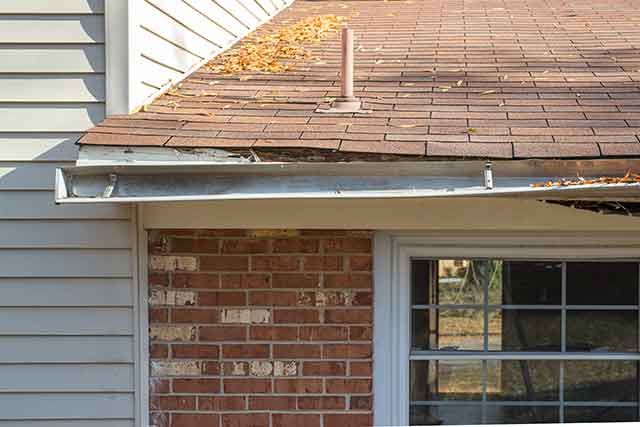Did your roof fare the recently high winds? NWSBoulder recently reported wind gusts up to 80mph in wind-prone areas in the Colorado foothills. Is there any damage to your roof? Do you know what to look for? Before the next rain, hail, or high wind storm, you’ll want to have a look at your roof to make sure it’s ready, and fix any damages. If you don’t feel like getting on your roof, we don’t blame you. That’s why we offer free roof inspections in Colorado. Some signs of roof damage are obvious. However, some aren’t. Below are things to look for. If you’d rather, contact us for a free roof inspection.

What to Check For
- Damaged Roofing Material
- Loose Roofing Material
- Missing Roofing Material
- Fallen Tree Branches
- Accumulated Debris
- Damaged Flashing
- Missing Flashing
- Bent Roofing Material
- Bent Flashing
- Damaged Gutters
Damaged Roofing Material
During high winds, roofing material, such as asphalt shingles or flashing, can bend. If you notice bent asphalt shingles or sheet metal, you’ll want to get that damaged material repaired and secured back down before the next high wind storm or rain storm. Otherwise, it will only get worse and cause more damage. Fallen tree branches can also damage roofs. Depending upon the size of the branch, it can puncture your roof or damage flashing. Punctured or bent roofing material often results in a water leak. It’s in your best interest if you straighten and re-seal that roofing material right away.
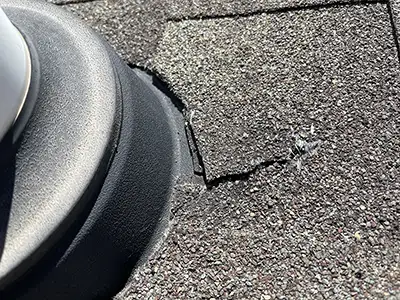
Loose Roofing Material
Loose roofing material is sometimes obvious. Sometimes it’s still on your roof, but not in place. However, sometimes it’s hard to notice. Sometimes you have to gently see if you can pick-up the material to see if it’s loose. If you can get your finger under the material, it’s loose and in need of repair. You should secure it back down right away. Otherwise, loose roofing will only loosen more in the next high wind or cause a water leak in the next rain storm. Depending upon what the material is, you might secure it down with a nail or screw, or construction sealant.
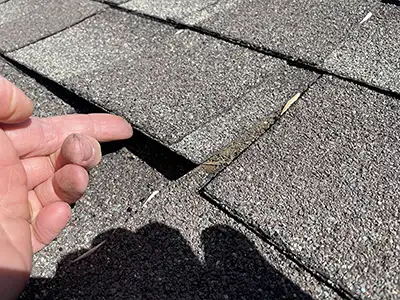
Missing Roofing Material
Missing roofing material in Colorado, such as missing asphalt shingles, sheet metal, or tiles leave your roof vulnerable. Your roof covering, such as asphalt shingles, are your roof’s first line of defense against rain, hail, ultraviolet rays, wind, etc. Without it, your roof will quickly deteriorate and leak. That’s why it’s important to replace any roofing material right away. Sometimes missing roofing material is obvious from the ground. However, you might need to get on your roof to get a better look. If you are missing any shingles or flashing or sheet metal, get it replaced. You can often get scrap roofing material from your local Habit ReStore. If not, feel free to contact us for a free roof inspection and estimate in Colorado. No roof job is too big or too small for us. 🙂
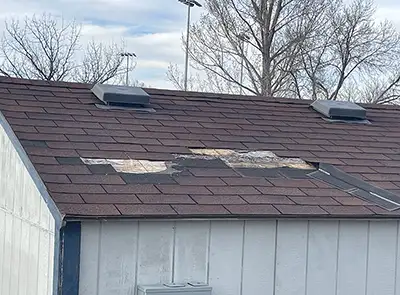
Fallen Tree Branches
Fallen tree branches are common after wind storms in Colorado. Large tree branches on your roof often cause major damage in the form of holes in your roof covering, cracked or broken shingles or tiles, and unsealed roofing material. Small tree branches on your roof can also cause damage. Small branches on your roof can cause the granules on your asphalt shingle roof to rub off. They also invite pests, such as insects, to make a home on your roof. If left for a long time, branches can rot on your roof and cause more problems. If you notice tree branches on your roof, you’ll want to remove them as soon as possible to prevent further roof damage in Colorado.
Accumulated Debris
Strong winds often shake loose pine needles and leaves, only to fall and collect onto your roof. If these are left on your roof, they build-up and begine to rot and decay. This pile of rotting leaves is inviting to insects and birds, as well as rot and mold. Debris left on your roof to decay will only degrade your roof quicker. As soon as possible, you should clean your roof of any debris. If you’re undercomfortable doing so, search on-line for a gutter cleaning service. Often, they will not only clean your gutters, but also remove any leaves and branches on your roof.
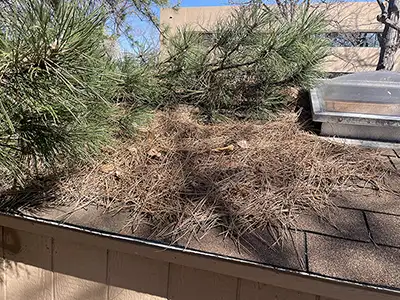
Damaged Flashing
Flashing is the sheet metal around stovepipes, chinmeys, vents, and around your roof’s edge. Sometimes during strong winds, flashing gets damaged or unsealed. If you find any damaged flashing on your roof, be sure to seal it before the next rain or wind storm. Be sure to repair damaged flashing as soon as possible. Flat head nails and construction sealant work great for this. Torn flashing might need replacing. If you notice you have any damaged flashing, feel free to contact us for a free inspection and estimate. No roofing job is too big or too small for us. Honestly.
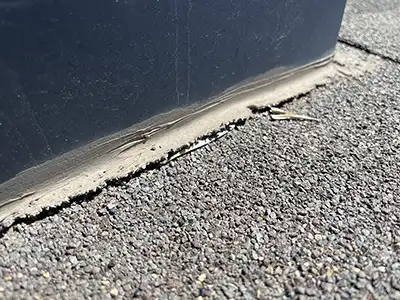
Missing Flashing
Missing flashing, just like any missing roofing material, is a serious problem. Flashing goes under your roof covering, such as asphalt shingles, and around vents, such as chimneys and vents. It’s also found along the roof edge. Flashing is there to help redirect water away from your roof. If it’s missing, water can easily get onto your roof deck and cause costly problems. If the wind has torn away any flashing from your roof, contact us for a free roof repair estimate.
Damaged Gutters
Roofs aren’t the only thing damaged by high winds. Gutters are also susceptible to damage. Strong winds can tear gutters away from your house. Falling tree branches can damage gutters. Gutters and downspouts help to redirect water away from your roof and property. If they’re damaged, they might not be able to do their job effectively. If your gutters have been damaged by high winds or fallen tree branches, you’ll want to get them fixed right away. Not only do we repair roofs, we also repair or replace gutters. If your gutter is damaged, feel free to contact us for a free inspection and estimate.
